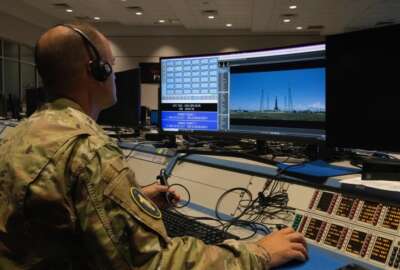

Gwen DeFilippi, Air Force assistant deputy chief of staff for manpower, personnel and services, said a new data lake will lead the service to having better pers...
Gwen DeFilippi, Air Force assistant deputy chief of staff for manpower, personnel and services, said a new data lake will lead the service to having better personnel systems.
The Air Force has been working with a 1980s talent management and personnel model for the past several years and its vestiges have left the service with some issues recruiting and retaining the airmen in an all-volunteer force for 21st century jobs.
Part of the answer to correcting that issue is collecting and utilizing data to better the lives of airmen, giving them the tools they need to succeed and putting them in positions to accomplish their mission.
The Air Force is currently working on major projects that it thinks will give airmen those opportunities.
“We’re using dashboards to empower our personnel at the lowest levels up through the highest levels to really understand the landscape and to be better able to inform and advise commanders who are making decisions,” said Gwen DeFilippi, Air Force assistant deputy chief of staff for manpower, personnel and services. “We’re also using data to be predictive. We are at a place where technologies from the commercial sector are putting us in a place where we’re going to be positioned to understand what’s likely to change based on the actions we take.”
DeFilippi said the biggest issue facing the Air Force right now is the war for talent in attracting and retaining the best service members and civilians.
The Air Force is using the talent marketplace to better place airmen in jobs that will fit their skills and preferences.
“Right now it’s rolled out to officers, and we’re starting to bring it into the enlisted workforce,” DeFilippi said. “It allows an officer to go in and describe their competencies and capabilities and bid on jobs. It also allows people that own jobs, for the first time, to see the available talent and express preferences about who they’d like to hire.”
DeFilippi said tools like that let airmen flourish in their careers all by using data.
Collecting and harnessing data needs proper IT systems to ensure the airmen and leaders are using the data properly.
That is why the Air Force human resource community is modernizing its data system.
“We’re working to move from about 120 different individual systems that support the way we do business to five or six broad kinds of platforms,” DeFilippi said. “They rely on best industry practices, platform as a service and software as a service kinds of technologies.”
One of those services involves creating a large data lake of talent management information.
“We’re almost finished creating that,” she said. “That had to go first because in order for us to implement other parts of the system we have to have the master personnel file for military members in the Air Force. We’ll be changing how we do customer relations management and we’re in the final stages of getting approval and making contracting actions to implement that software as a service solution.”
DeFilippi said that data lake lets the Air Force develop more dashboards, applications and data visualization tools to support squadrons.
Those technologies allow the Air Force to hire its civilians faster, place airmen better, communicate talent needs between squadrons and even ensure pay is accurate and on time.
“We ended conscription in the 1970s, but out system still really relies on that same sort of concept that we can tell people what we want them to do and they’ll just do it because they have to,” DeFilippi said. “We really have to do things differently. We’ve been working on moving away from a one-size-fits-all approach to development.”
The Air Force is doing that for the first time by using its most recent promotion board to implement custom developmental career pathways for different Air Force specialties.
Informed by data, the new pathways create career roadmaps that are specialized to different jobs.
“This change is about ensure we maintain a winning team,” Air Force Chief of Staff Gen. David Goldfein said last fall. “The existing line of the Air Force category served our Air Force well and molded the excellent leaders we have today. As we look to the future of warfighting, we must have an agile system that allows for a wider range of development paths to ensure officers have the needed skills and expertise to fight and win. This sets up that path.”
Copyright © 2024 Federal News Network. All rights reserved. This website is not intended for users located within the European Economic Area.
Scott Maucione is a defense reporter for Federal News Network and reports on human capital, workforce and the Defense Department at-large.
Follow @smaucioneWFED

